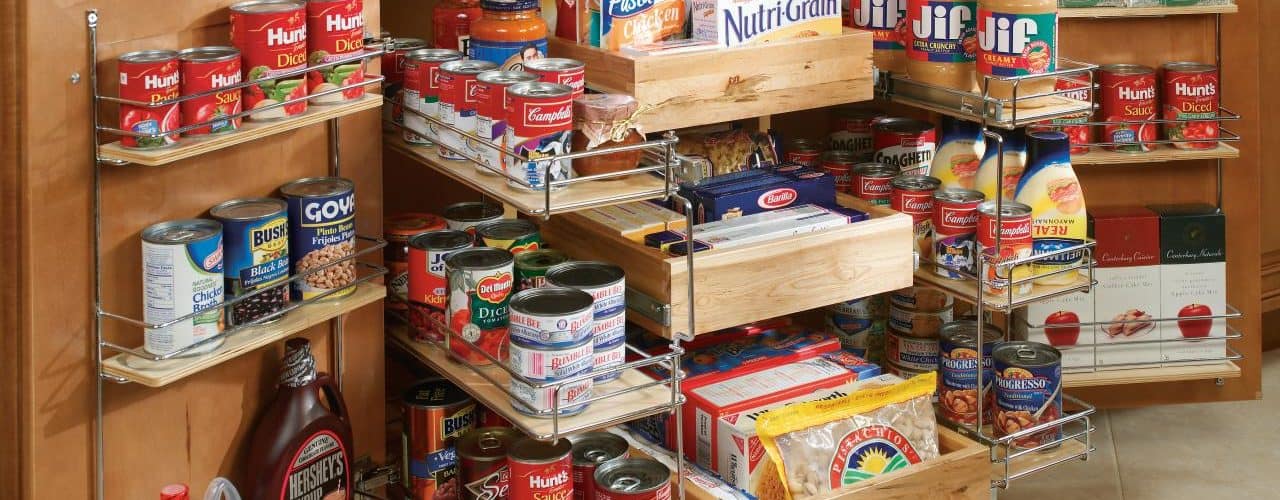There are numerous benefits to strategically organizing your kitchen or pantry cabinets. Disorganization of your food can lead to purchasing too much or too little of any given grocery item. Thus, it most certainly leads to a waste of valuable time, energy and money as it results in “duplicate” shopping and stimulates impulsive buying habits. Disorganization can also disrupt the flow of cooking meals and make even a large kitchen seem very small. Therefore, it’s essential to know how to organize your pantry cabinets.
Strategic organization
Although most people attempt to organize their pantry cupboards, they fail to do it strategically. Strategic organization means to arrange everything so that the kitchen functions effectively while still maintaining its appeal. This means storing everything in a way that makes each item easily accessible at a moment’s notice without taking up too much space. Following these steps will help you do this:
Step 1 – Purchase or build actual pantry cabinets or convert your standard cupboard into being more like a pantry cabinet if all you have are standard kitchen cupboards. There’s a wide selection of types of pantry cabinets available, including those with pull-out panels, drawers, sliding shelves, bins, or sliding doors. Even an inexpensive armoire can be used as a pantry cabinet. When selecting a pantry cabinet, keep in mind the types of items that will be stored in them. Also remember that it’s easier to find items if the cupboard has a light-colored interior and light. The shelves should be adjustable to accommodate varying heights, and at least some should be shallow enough to keep smaller items from becoming hidden.
Step 2 – Take everything out of the cupboards and sort the items, grouping them according to like items. Get rid of anything that can no longer be used or that is likely not going to be used. You can group the items according to type of container (i.e. can, box, and jar) or by how frequently they are used (i.e. daily, weekly, monthly, on rare occasions). Or you can group the ingredients according to type of ethnic cuisine. You can also sort them by type of food, such as ingredients for baking, spices, vegetables, fruits, snacks and cereals. It doesn’t matter which way you group the items, as long as the grouping makes it easy and quick for you to find and use every item.
Step 3 – Purchase or make kitchen organization accessories that help you store and keep these items sorted out by their specific groups. These accessories can range from simple space dividers and plastic containers to fancy turntables, woven baskets and hanging wire racks. It’s best to sort everything into groups before buying organizing accessories because over-estimating or under-estimating what is needed can easily defeat the purpose of organizing the kitchen. It can also become more costly and time consuming if you have to go back to purchase more organizing aides later.
Step 4 – Clean items off and store them into their proper places. Use shelf labels to help train everyone to put items where they belong. This also helps any guests or childcare providers to feel more comfortable when they are putting away groceries or preparing a meal.
More tips
Getting and staying organized may still seem to be a bit overwhelming to some people. They may be confused as to what type of accessory to use for each type of item or which pantry cabinet style would best suit their own needs. So here are a few more tips that might help to reduce the confusion:
- The more shelves you have, then the easier it is to organize all items
- The shallower a shelf is, then the easier it is to find items that have been placed on that shelf
- Some items will be too tall or too wide to fit on shallow, closely spaced shelves so leave a few tall, deep spaces for storing these items
- Remember that you may need to occasionally adjust the spacing of the shelving or regroup items as you add more items to the cabinets, so use temporary labels instead of permanent ones.
- Place a notepad/grocery list handy so you can add items when you begin to run low of the stocked item.
- Place the pantry cabinets close to your workspaces so you can easily reach an item while cooking, serving or cleaning up from a meal. There are many styles of free-standing cabinets, and some may be easily moved about as needed.
- Don’t overstuff the cabinets. If more storage space is needed, then add more cabinets or shelving to the kitchen.
- Remember that some items can take up less space and last longer if they are removed from the original package and placed in another type of container. For example, a box of cereal will stay fresher and store better if it’s placed in a tightly-sealed plastic container.
- Utilize a step-up ladder to reach the higher shelves more easily and to reduce wasted kitchen space
The main thing to remember is that this organization is to make life easier for you. So keep it as simple as possible and stay within your own budget. Remember that storage space can utilize hanging things up as well as placing them in bins, baskets, plastic tubs, wooden boxes, or drawers. Don’t be afraid to use your imagination to come up with your own creative ways of storing items. Now you can get started on enjoying all the benefits of a well-organized pantry since you now know how to organize your pantry cabinet.


